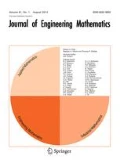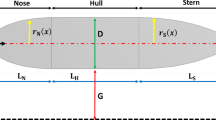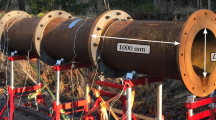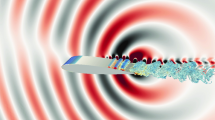Abstract
Air motion representative of some of the flows past a moving car is studied, particularly in the gap between the car underbody (undertray, front flap or forewing) and the ground, using theory and computation. The ground-affected flows encountered are two- or three-dimensional, laminar, transitional or turbulent, and attached or separated. Given Reynolds numbers in the approximate range 1–10 million, emphasis here is placed first on key physical flow mechanisms: viscous-inviscid interaction filling either much or part of the gap; the generation of strong upstream influence; an abrupt pressure jump at the leading edge; the moving-ground condition; substantial diffuser flow reversals and wake effects; in three dimensions the distinguishing between inflow and outflow edges; and turbulent flow modelling. Second, for various underbody shapes, predictions are presented of the surface pressures and shear stresses, the lift or downforce, and the velocity profiles. Extensions of these to include edge effects, three-dimensionality and turbulence modelling are examined, along with optimization for certain shapes concerned with front-flap design and comparisons with recent experiments.
Similar content being viewed by others
References
R.G. Dominy, The influence of slipstreaming on the performance of a Grand Prix racing car. J. Automobile Eng. (Proc. I. Mech. Eng.) 204 (1990) 35–40.
R.G. Dominy, Aerodynamics of a Grand Prix racing car. J. Automobile Eng. (Proc. I. Mech. Eng.) 206 (1992) 267–274.
P.G. Wright, The influence of aerodynamics on the design of Formula One racing cars. Int. J. Vehicle Design 3. (1982) 383–396.
J. Katz, Investigation of negative lifting surfaces attached to an open-wheel racing car configuration. Int. Congr. & Exposition Detroit, Michigan, Feb.25-Mar.1, SAE tech. ppr. 850283 (1985) pp. 383–396.
J. Katz, Calculation of the aerodynamic forces on automobile lifting surfaces. J. Fluids Eng., Trans. A.S.M.E. 107 (1985) 438–443.
K. Jacob, Advanced method for computing flow around wings with rear separation and ground effect. J. Aircraft 24 (1986) 126–128.
Y.B. Suh. and C. Ostowari, Drag reduction factor due to ground effect. J. Aircraft 25 (1988) 1071–1072.
P.W. Bearman, Bluff body flows applicable to vehicle aerodynamics. In: T. Morel and C. Dalton (eds.), Aerodynamics of Transportation. New York: A.S.M.E., (1980) pp. 265–274.
M.D. Chawla, L.C. Edwards and M.E. Franke, Wind-tunnel investigation of wing-in-ground effects. J. Aircraft 27 (1990) 289–293.
M.A. Jones, Mechanisms in Wing-in-Ground Effect Aerodynamics. Ph.D. thesis. Univ. of London (2000) 210 pp.
S.E. Widnall and T.M. Barrows, An analytical solution for two-and three-dimensional wings in ground effect. J. Fluid Mech. 41 (1970) 769–792.
J.N. Newman, Analysis of small-aspect-ratio lifting surfaces in ground effect. J. Fluid Mech. 117 (1982) 305–314.
E.O. Tuck and M. Bentwich, Sliding sheets: lubrication with comparable viscous and inertia forces. J. Fluid Mech. 135 (1983) 51–69.
A.Z. Szeri, Some extensions of the lubrication theory of Osborne Reynolds. J. Tribology, Trans. A.S.M.E. 109 (1987) 21–36.
J.A. Tichy, Entry flow in a narrow channel of varying gap with one sliding surface. J. Tribology, Trans. A.S.M.E. 108 (1986) 288–293.
A. Plotkin and S.S. Dodbele, Slender wing in ground effect. A.I.A.A. J. Tech. Note. 26 (1988) 493–494.
S.K. Wilson and B.R. Duffy, On lubrication with comparable viscous and inertia forces. Quart. J. Mech. Applied Maths. 51 (1998) 105–124.
O.E. Jensen, The stress singularity in surfactant-driven thin-film flows. Part 2. Inertial effects. J. Fluid Mech. 372 (1998) 301–322.
F.T. Smith, Flow through symmetrically constricted tubes. J. Inst. Maths. Applics. 21 (1978) 145–156.
F.T. Smith and P.W. Duck, On the severe nonsymmetric constriction, curving or cornering of channel flows. J. Fluid Mech. 90 (1980) 727–753.
F. Ernst and M. Perić, Kombinierte experimentall-numerische Strömungsuntersuchungen an einen zweidimensionelen Fahrzeungmodell. LSTM Bericht 182/I/87, Lehrstuhl für Stromungsmechanik, Univ. Erlangen-Nürnberg, Germany (1987) 37 pp.
F.T. Smith, On physical mechanisms in two-and three-dimensional separations. Phil. Trans. R. Soc. London A (theme issue) 358 (2000) 3091–3111.
F.T. Smith and M.A. Jones, One-to-few and one-to-many branching tube flows. J. Fluid Mech. 423 (2000) 1–31.
R.G.A. Bowles and F.T. Smith, Lifting multi-blade flows with interaction. J. Fluid Mech. 415 (2000) 203–226.
F.T. Smith and S.N. Timoshin, Blade-wake interactions and rotary boundary layers. Proc. R. Soc. Lond. A 452 (1996) 1301–1329.
F.T. Smith and S.N. Timoshin, Planar flows past thin multi-blade configurations. J. Fluid Mech. 324 (1996) 355–377.
F.T. Smith, Boundary layer flow near a discontinuity in wall conditions. J. Inst. Maths. Applics. 13 (1974) 127–145.
F.T. Smith and P.G. Daniels, Removal of Goldstein's singularity at separation in flow past obstacles in wall layers. J. Fluid Mech. 110 (1981) 1–37.
F.T. Smith, Interacting flow theory and trailing edge separation-no stall. J. Fluid Mech. 131 (1983) 219–249.
F.T. Smith, Pipeflows distorted by non-symmetric indentation or branching. Mathematika 23 (1976) 62–83.
R.I. Sykes, On three-dimensional boundary layer flow over surface irregularities. Proc. R. Soc. London A 373 (1980) 311–329.
R. Purvis, Rotor Blades and Ground Effect. Ph.D. thesis, University of London (2002) 230 pp.
L. Li, J.D.A. Walker, R. Bowles and F.T. Smith, Short-scale break-up in unsteady interactive layers: local development of normal pressure gradients and vortex wind-up. J. Fluid Mech. 374 (1998) 335–378.
D.J. Savin, F.T. Smith and T. Allen, Transition of free disturbances in inflectional flow over an isolated surface roughness. Proc. R. Soc. London A 455 (1999) 491–541.
T. Cebeci and A.M.O. Smith, Analysis of Turbulent Boundary Layers. New York: Academic Press (1974) 404 pp.
R.I. Sykes, An asymptotic theory of incompressible turbulent boundary-layer flow over a small hump. J. Fluid Mech. 101 (1980) 647–670.
P. Bradshaw, Prediction of the turbulent near-wake of a symmetrical airfoil. A.I.A.A. J. 8 (1970) 1507–1512.
G.L. Mellor, The large Reynolds number, asymptotic theory of turbulent boundary layers. Int. J. Eng. Sci. 10 (1972) 851–873.
W.B. Bush and F.E. Fendell, Asymptotic analysis of turbulent channel and boundary-layer flow. J. Fluid Mech. 56 (1972) 657–681.
A. Neish and F.T. Smith, On turbulent separation in the flow past a bluff body. J. Fluid Mech. 241 (1992) 443–467.
A.T. Degani, F.T. Smith and J.D.A. Walker, The structure of a three-dimensional turbulent boundary layer. J. Fluid Mech. 250 (1993) 43–68.
G.I. Taylor, The dispersion of matter in turbulent flow through a pipe. Proc. R. Soc. London A 233 (1954) 446–468.
A. Purnama, Boundary retention effects upon contaminant dispersion in parallel flows. J. Fluid Mech. 195 (1988) 393–412.
A. Silva-Freires, An Asymptotic Approach for Shock Wave/Turbulent Boundary Layer Interaction. Ph.D. thesis, University of Cambridge (1990) 245 pp.
F.T. Smith and S.N. Timoshin, Vortex-generator jets: theoretical prediction and design. Utd. Techn. Res. Cent. report. UTRC94–93, East Hartford, CT, USA (1994) 32 pp.
J. Zerihan and X. Zhian, Aerodynamics of a single element wing in ground effect. J. Aircraft 37 (2000) 1058–1064.
J. Zerihan and X. Zhang, Aerodynamics of Gurney flaps on a wing in ground effect. AIAA J. 39 (2001) 772–780.
Author information
Authors and Affiliations
Rights and permissions
About this article
Cite this article
Jones, M., Smith, F. Fluid motion for car undertrays in ground effect. Journal of Engineering Mathematics 45, 309–334 (2003). https://doi.org/10.1023/A:1022626814273
Issue Date:
DOI: https://doi.org/10.1023/A:1022626814273




